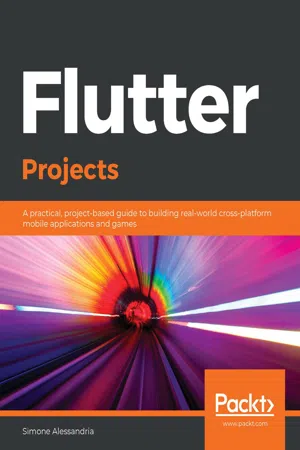
Flutter Projects
A practical, project-based guide to building real-world cross-platform mobile applications and games
- 490 pages
- English
- ePUB (mobile friendly)
- Available on iOS & Android
Flutter Projects
A practical, project-based guide to building real-world cross-platform mobile applications and games
About this book
Learn Flutter and the Dart programming language by building impressive real-world mobile applications for Android and iOS
Key Features
- Learn cross-platform mobile development with Flutter and Dart by building 11 real-world apps
- Create wide array of mobile projects such as 2D game, productivity timer, movie browsing app, and more
- Practical projects demonstrating Flutter development techniques with tips, tricks, and best practices
Book Description
Flutter is a modern reactive mobile framework that removes a lot of the complexity found in building native mobile apps for iOS and Android. With Flutter, developers can now build fast and native mobile apps from a single codebase.
This book is packed with 11 projects that will help you build your own mobile applications using Flutter. It begins with an introduction to Dart programming and explains how it can be used with the Flutter SDK to customize mobile apps. Each chapter contains instructions on how to build an independent app from scratch, and each project focuses on important Flutter features.From building Flutter Widgets and applying animations to using databases (SQLite and sembast) and Firebase, you'll build on your knowledge through the chapters. As you progress, you'll learn how to connect to remote services, integrate maps, and even use Flare to create apps and games in Flutter. Gradually, you'll be able to create apps and games that are ready to be published on the Google Play Store and the App Store. In the concluding chapters, you'll learn how to use the BLoC pattern and various best practices related to creating enterprise apps with Flutter.
By the end of this book, you will have the skills you need to write and deliver fully functional mobile apps using Flutter.
What you will learn
- Design reusable mobile architectures that can be applied to apps at any scale
- Get up to speed with error handling and debugging for mobile application development
- Apply the principle of 'composition over inheritance' to break down complex problems into many simple problems
- Update your code and see the results immediately using Flutter's hot reload
- Identify and prevent bugs from reappearing with Flutter's developer tools
- Manage an app's state with Streams and the BLoC pattern
- Build a simple web application using Flutter Web
Who this book is for
This book is for mobile developers and software developers who want to learn Flutter to build state-of-the-art mobile apps. Although prior experience with Dart programming or Flutter is not required, knowledge of object-oriented programming (OOP), data structures and software design patterns will be beneficial.
Frequently asked questions
- Essential is ideal for learners and professionals who enjoy exploring a wide range of subjects. Access the Essential Library with 800,000+ trusted titles and best-sellers across business, personal growth, and the humanities. Includes unlimited reading time and Standard Read Aloud voice.
- Complete: Perfect for advanced learners and researchers needing full, unrestricted access. Unlock 1.4M+ books across hundreds of subjects, including academic and specialized titles. The Complete Plan also includes advanced features like Premium Read Aloud and Research Assistant.
Please note we cannot support devices running on iOS 13 and Android 7 or earlier. Learn more about using the app.
Information
Firing Up the App - Integrating Firebase into a Flutter App
- Creating a Firebase project
- Adding Firebase and Firestore to your app
- Reading data from a Firestore database and showing it in your Flutter app
- Implementing an authentication screen and connecting it to Firebase
- Writing data to a Firestore database (create, read, update, delete (CRUD))
Technical requirements
- The Flutter Software Development Kit (SDK).
- When developing for Android: the Android SDK, easily installed by Android Studio.
- When developing for iOS: macOS and Xcode.
- An emulator (Android), a simulator (iOS), or a connected iOS or Android device with debugging enabled.
- An editor: Visual Studio Code (VS Code), Android Studio, or IntelliJ IDEA are recommended. All should have the Flutter/Dart extensions installed.
- For this chapter, a Google account is required to use Firebase.
Introducing Firebase
Project overview


Adding Firebase to your Flutter project
- The container of all services in Firebase is a project. So, we'll begin building our app by creating a new Firebase project.
Table of contents
- Title Page
- Copyright and Credits
- Dedication
- About Packt
- Contributors
- Preface
- Hello Flutter!
- Miles or Kilometers? Using Stateful Widgets
- My Time - Listening to a Stream of Data
- Pong Game - 2D Animations and Gestures
- Let's Go to the Movies - Getting Data from the Web
- Store That Data - Using Sq(F)Lite To Store Data in a Local Database
- Firing Up the App - Integrating Firebase into a Flutter App
- The Treasure Mapp - Integrating Maps and Using Your Device Camera
- Let's Play Dice: Knockout - Creating an Animation with Flare
- ToDo App - Leveraging the BLoC Pattern and Sembast
- Building a Flutter Web App
- Appendix
- Assessment
- Other Books You May Enjoy